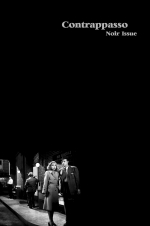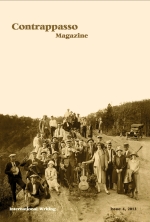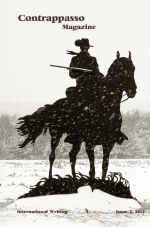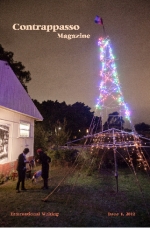An Interview with Richard Misek
Richard Misek is film-maker, media theorist, and educator. He has a professional background as a video editor and motion graphics designer, and is a former Knox Fellow at Harvard University. His teaching focuses on digital film-making, and encompasses fiction, documentary, and experimental forms. His current research explores the interstices between cinema and digital media, and extends across traditional scholarship and practice-based research/film-making. He is the author of the book Chromatic Cinema (Wiley-Blackwell, 2010) and of numerous articles on moving image aesthetics and technologies.
Misek is also the director of the feature-length documentary Rohmer in Paris (2013), which has screened in five continents and received widespread critical acclaim.
I recently caught Rohmer in Paris at the BAFICI film festival in Buenos Aires. Richard and I swapped some emails on the new documentary.
MATTHEW ASPREY: What was the process of making this film?
RICHARD MISEK: I’d just come out of a very happy four years in which I’d been working on a film PhD in Melbourne, and I was now starting a job teaching film history at Bristol University. It was a miserable wet autumn, and I was in temporary accommodation in a new city, bored and depressed, with just a laptop for company and the university library two minutes’ walk away. Over the course of three months, I watched almost the entirety of the library’s video collection. They didn’t have much, but they did have a complete set of Rohmer’s films, so I watched them night after night, voraciously, and gradually found myself drawn into his weirdly unchanging world.
What most interested me about the films, beyond the fact that they transported me somewhere more interesting than Bristol, was the spatial fidelity that Rohmer displayed towards Paris. He was so loyal to the city’s topography that he couldn’t allow himself to do what most film-makers do, which is to cheat physical space to fit the narrative requirements of their film. So, for example, Rohmer would film a scene that involved someone walking down Rue de Lévis with strict physical continuity. Like his characters, his actors and his camera crew would move step-by-step down the street. It’s such a ridiculous but also admirable constraint for a film-maker to impose on himself, and the result is a kind of spatial ‘truthfulness’ very rare in cinema. I don’t think it necessarily makes the films any better, but it provides an extra layer of interest.
So Rohmer in Paris initially took the form of a straightforward academic project about Rohmer’s relation to the topography of Paris – I presented seminars, and gave conference talks on the subject, and started to draft a book chapter about it (it’s now in a book called Mapping Cultures edited by Les Roberts). At the same time, for a long while I’d been interested in the idea of using film to interrogate film. Given the technology that’s now available, why should film critics and historians still restrict themselves to using only text? So I began to work on a short video essay on Rohmer’s Paris. Within a few months, I’d made a 15-minute work called ‘Mapping Rohmer’ but it felt too short to do justice to the complexity of Rohmer’s relationship with the city, so I just kept on going. Three years later, I finished the film!

MA: Your film isn’t a traditional documentary but rather an essay film on Rohmer, on his vision of Paris, on your obsession with his work, and on the ultimate futility of cinephilia. And it’s also a love letter to the late director; at one moment you stop to confess to him, ‘I love you’. How do you define Rohmer in Paris and did you ever consider a more traditional documentary?
RM: I like that it’s a difficult film to define, so I don’t define it. In fact, for a long time, I didn’t even consider it to be a film, never mind a documentary. But then at some point, I’d spent so long with Rohmer’s footage that my own life as a viewer began to be reflected in it, and what had been a research project turned into something else. I don’t quite know when it happened – maybe after a year or so – that I realised there was a narrative there too, and that what I was actually doing was making a film. But by that point it was already such a hybrid, that it was too late to make it a traditional documentary. I remember there was a moment, after I’d first showed the film to friends and many of them really didn’t like it, that I thought ‘Screw it, maybe I’ll just make a straight doc on Rohmer and try to sell it to a couple of TV stations’. But that would have been a terrible mistake – a compromise that nobody had even asked me to make.
The whole experience does, however, strengthen my belief that we are in a period in which traditional categories (‘fiction’, ‘documentary’, even ‘film’) count ever less. Yes, the old institutional divisions between types of film, and between film and other media, still exist; but speaking as a viewer, I increasingly feel that the most exciting work occupies the liminal spaces between forms, and the most interesting films somehow try to renegotiate what film is. I think that’s what I was trying to do with my film, in my own small way.
MA: What other non-fiction films do you see as antecedents?
RM: Now I look at the film, it seems to fit quite clearly into the ‘essay film’ category, and sometimes even feels like a conventional documentary. But for most of the time I was making it, I really didn’t know where I was going with it, and I certainly didn’t have any models for what I was trying to achieve. I looked at many films – like Godard’s Histoire(s) du cinéma (1988-98), but they typically didn’t help me solve my specific problems. I would say, though, that two works that very much inspire me are Sans Soleil (1983) and Los Angeles Plays Itself (2003). Again, I didn’t draw any specific lessons from them, but indirectly I think Rohmer in Paris owes a lot to both. Without Sans Soleil, I don’t think I’d have had the nerve to include the personal elements of the film, and without the inspiration of Los Angeles Plays Itself I don’t think I’d have had the self-discipline to make a film (almost) entirely out of appropriated footage.
MA: Did you meet the frustration film essayists often encounter when legally or financially prohibited from quoting other films for the purpose of criticism? Los Angeles Plays Itself – Thom Anderson’s now-classic essay on cinema and a city – was also playing at the BAFICI festival, although its legal status remains dubious, effectively underground, because it was produced without permissions. These are not problems literary critics normally face because of ‘fair use’ provisions of copyright law. Was it difficult or expensive to acquire the rights to use such extensive clips from Rohmer’s films?
RM: If you work with no money and expect to earn no money, there are no constraints to what footage you can use. It would have been impossible to acquire rights to use all the clips that I used – the going rate is about €80 a second, not to mention the many hours for which you’d have to employ a legal expert to negotiate it all. I’d have needed a budget of over half a million Euros! Instead, I took the only option faced by almost all artists who draw on the media landscape – I just ripped DVDs and prepared myself to invoke fair dealing if anyone questioned the critical integrity of my project. As a result of making Rohmer in Paris, I now know so much about Intellectual Property, I’ve actually started writing about it as an academic. In fact, funny you should mention the ambiguous legal status of Los Angeles Plays Itself, as I’ve just finished writing a 10,000 article on just that subject! In short: yes, LAPI has never had a full commercial release, and there are certainly economic reasons for that, but the landscape is rapidly changing. Mark Cousins’ The Story of Film was made almost entirely from ripped DVDs, and sold to over fifty broadcasters without any major problems. I started this project feeling quite pessimistic about artists being able to use their moral right to work with found footage. I was also very pessimistic about my own chances of finding anyone who’d even want to screen it. But the last half year of exhibiting the film, and seeing how many other people are ‘getting away with’ using media in their work, has made me much more optimistic. The cultural ground is shifting, and intellectual property holders only have so much power to resist it.
MA: You explore the notion of Rohmer as a psychogeographical filmmaker. Can you elaborate on that? Did Rohmer have any connection to the Guy Debord and the Situationist International?
RM: No, he had no direct connection to them. I don’t know if he even read Baudelaire or Benjamin. Maybe he did, but he never mentioned them. Rather, my sense is that Rohmer’s spatial/urban project was far more intuitive than intellectual. There’s a great article he wrote for the 50th anniversary of Positif in which Rohmer registers his mild frustration with the fact that the train in Buster Keaton’s The General once travels screen left to screen right, and then travels screen right to screen left. He can’t say why – it just bothers him. Rohmer didn’t analyse psychogeography, he embodied it.
MA: Gene Hackman delivers a famous line in Arthur Penn’s Night Moves (1975) that watching a Rohmer film is ‘kind of like watching paint dry’. Do you think that is still the general attitude to his work?
RM: Personally, I find watching Night Moves to be like watching paint dry, so to each his own! I’m certainly not trying to champion Rohmer. I’m not even sure that he’s one of my favourite directors. I never made a rational decision that I liked his work, I just fell in love with him. Trying to be objective, though, I think there’s a so much Rohmer’s films to be interested in, and I look forward to future writers and film-makers seizing on aspects of his work that I haven’t even touched. There’s plenty more to explore.
MA: And finally, could you tell us which of Rohmer’s films is your favourite?
RM: L’amour l’après-midi (1972). Or maybe La Collectioneuse (1967). Or Le Rayon Vert (1986). Or La boulangère de Monceau (1963)… or…












